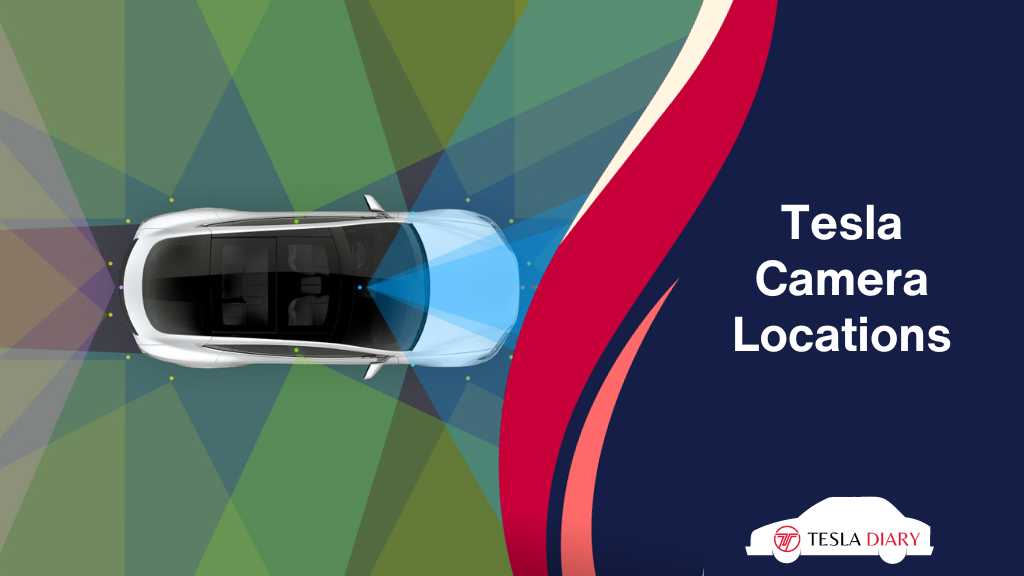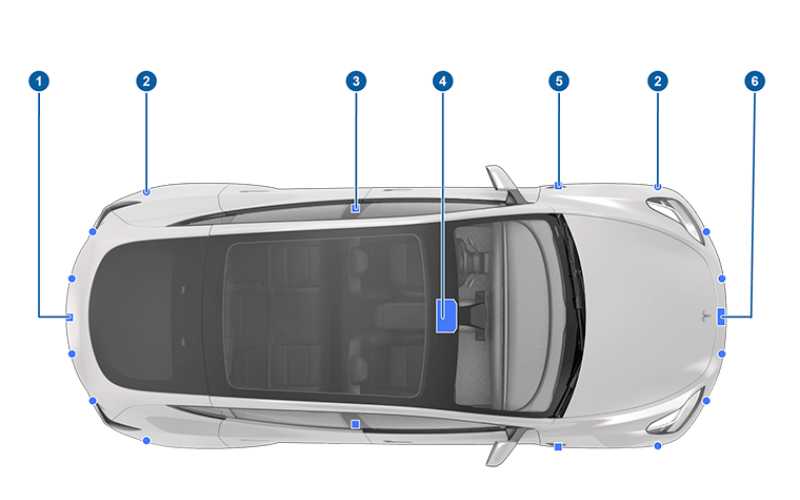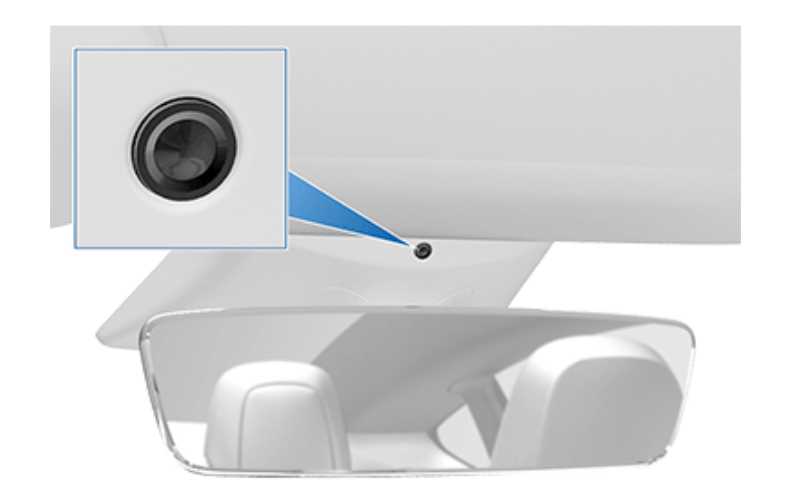Tesla is renowned not only for its cutting-edge EV technology but also for its advanced driver-assistance systems (ADAS) and Full Self-Driving (FSD) capabilities.
A crucial component of these systems is the array of cameras strategically placed around Tesla vehicles.
In this article, we will delve into the locations of these Tesla cameras, their purposes, and the role they play in enhancing the safety and autonomy of Tesla vehicles.

Where Are the Cameras in a Tesla?
Tesla Front Cameras
There are two locations on the front of your Tesla where you will find cameras-
1. Forward-Facing Cameras
Located behind the rearview mirror at the top of the windshield, Tesla vehicles feature multiple forward-facing cameras, usually three.
These cameras are crucial for detecting objects, vehicles, and lane markings ahead. They play a pivotal role in enabling features like adaptive cruise control, automatic lane-keeping, and traffic-aware cruise control.
So. make sure not to obstruct the view of these cameras by putting any shade or other object in front of them. [#4 in the image]

2. Front Bumper Cameras
On the front bumper, you can find additional cameras that offer a lower and more angled view compared to the forward-facing cameras on the windshield.
These cameras are instrumental in detecting objects, curbs, and road conditions closer to the vehicle’s front. [#6 in the image]
Tesla Side Cameras
There are a couple of locations on your Tesla where you will find side-view cameras-
3. Side-View Cameras
Tesla vehicles are equipped with cameras on each side, typically located on the front fenders.
These cameras provide a view of the vehicle’s blind spots, help with lane changes, and contribute to the vehicle’s Autopilot’s awareness of the surroundings. [#5 in the image]
4. B-pillar Cameras
Tesla Model 3 and Model Y feature cameras on the B-pillars between the front and rear doors.
These cameras aid in providing a more comprehensive view of the vehicle’s surroundings, especially when navigating tight spaces or parking. [#3 in the image]
Tesla Rear Cameras
5. Rearview Camera
A rearview camera is positioned above or near the rear license plate.
This camera assists the driver in reversing and parking by displaying a clear view of the area directly behind the vehicle on the infotainment screen.
It also contributes to Tesla’s parking and summon features. [#1 in the image]
6. Rear Bumper Cameras
Additional rear-facing cameras may be located on the rear bumper, providing a wider-angle view of the area behind the vehicle.
These cameras enhance the accuracy of parking and assist in detecting obstacles while reversing.
Tesla Interior Cameras
7. Cabin Camera
In the cabin, Tesla vehicles are equipped with a cabin-facing camera. This camera monitors the driver and passengers and plays a role in ensuring driver attentiveness.

While Tesla has indicated potential uses for this camera in the future, its primary function is to monitor driver engagement. When the car is in auto-pilot mode, it monitors you if you are attentive to the road or not. If you are not, the system makes noise so that you are alert.
How to View Camera Feeds on Tesla?
There are different ways to view live video coming from the Tesla cameras.
If you have a Model S or X, then follow this-
- Go to Controls
- Select Safety
- Select View Live Camera via Mobile App and toggle it on.
Once you enable Live camera view, you can use your Tesla app on the phone to monitor circumstances using Tesla built-in cameras.
The method is more or less similar in Model 3 and Y as well. Do the following-
- Go to Controls
- Select Safety & Security
- Activate View Live Camera via Mobile App
Purpose of Tesla Cameras: Enhancing Safety and Autonomy
Tesla’s innovative use of cameras in their vehicles is at the forefront of automotive technology, contributing significantly to both safety and autonomy. These cameras serve a multifaceted purpose, combining real-time data capture, processing, and analysis to create a comprehensive understanding of the vehicle’s surroundings.
Here’s a detailed look at the purposes of Tesla cameras with additional data and insights:
1. Collision Avoidance and Automatic Emergency Braking
Tesla vehicles are equipped with advanced driver-assistance systems (ADAS) that rely on cameras for collision avoidance.
These cameras continuously monitor the road ahead and detect objects, vehicles, and pedestrians.
When a potential collision is detected, the system can provide warnings to the driver and, if necessary, initiate automatic emergency braking (AEB).
According to a report by the National Highway Traffic Safety Administration (NHTSA), vehicles equipped with AEB systems experience a 50% reduction in rear-end crashes.
2. Adaptive Cruise Control (ACC)
Tesla’s cameras play a central role in adaptive cruise control (ACC), which maintains a safe following distance from the vehicle in front. The cameras track the speed and position of leading vehicles, adjusting the Tesla’s speed accordingly.
ACC reduces driver workload, improves battery efficiency, and has the potential to reduce rear-end collisions, as noted by the Insurance Institute for Highway Safety (IIHS).
3. Lane Keeping and Lane Departure Warning
Tesla vehicles use cameras to monitor lane markings and the vehicle’s position within its lane. This information enables features like lane-keeping assistance and lane departure warnings.
The cameras work together with sensors to ensure the vehicle remains within the designated lane.
According to IIHS, lane departure warning systems have the potential to prevent up to 85% of all lane departure crashes when widely adopted.
4. Autopilot and Full Self-Driving (FSD)
Tesla’s Autopilot and Full Self-Driving (FSD) capabilities rely heavily on camera data. The combination of cameras, radar, and ultrasonic sensors allows Tesla vehicles to navigate highways, city streets, and parking lots with varying degrees of automation.
Cameras provide crucial visual input, identifying road signs, traffic lights, and the movements of other vehicles.’Cameras provide crucial visual input, identifying road signs, traffic lights, and the movements of other vehicles.
A report by the RAND Corporation estimates that if 20% of the vehicles on the road were equipped with advanced driver assistance systems (ADAS) like Autopilot, it could potentially prevent 9% of all fatal crashes in the United States.
5. Parking Assistance and Summon
Tesla’s cameras facilitate parking and summoning capabilities. The cameras provide a 360-degree view of the vehicle’s surroundings, aiding in parking maneuvers and obstacle detection when summoning the vehicle remotely.
6. Driver Monitoring
The interior cabin camera is designed to monitor the driver’s attentiveness and engagement while Autopilot or FSD features are active. It ensures that the driver remains ready to take control of the vehicle when necessary.
Drowsy driving is responsible for thousands of fatalities each year, and driver monitoring systems can help reduce this risk by alerting drowsy or distracted drivers.
7. Continuous Improvement through Data Collection
Tesla collects anonymized data from its vehicles equipped with Autopilot and FSD features. This data includes camera footage and sensor information.
Tesla uses this data to improve the performance and safety of its systems through over-the-air software updates.
Conclusion
Tesla vehicles are equipped with a network of strategically positioned cameras that play a crucial role in enhancing safety, enabling advanced driver-assistance features, and contributing to the realization of Full Self-Driving capabilities.
Understanding the location and purpose of these cameras is essential for Tesla owners and enthusiasts interested in maximizing the capabilities of their vehicles and staying up-to-date with Tesla’s ongoing advancements in autonomous driving technology.

